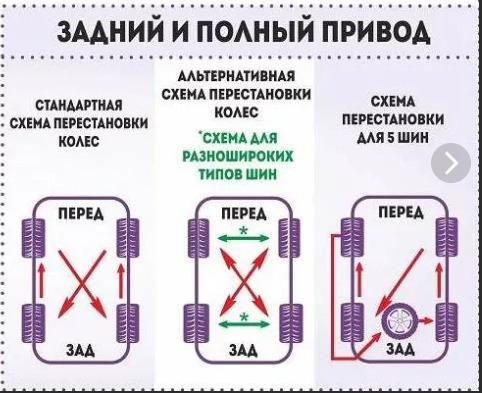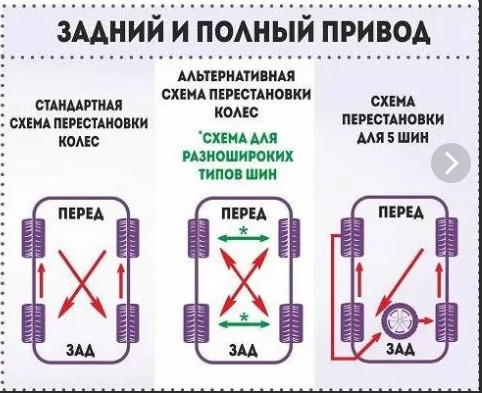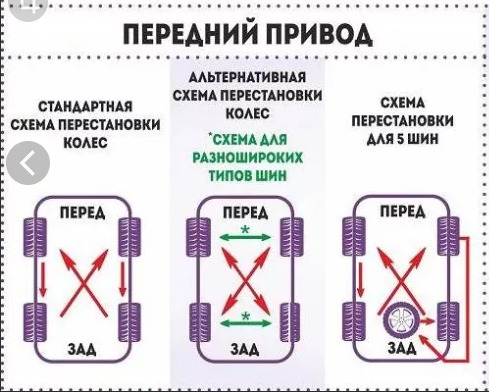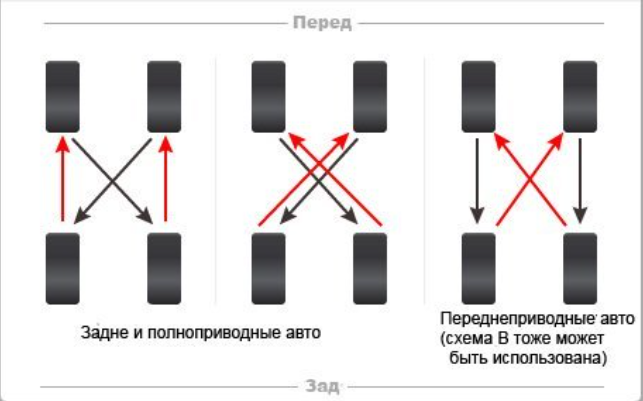
Changing wheels on a car with front and all-wheel drive. Schemes for a different number of wheels, tread pattern
Content
Manufacturers give a guarantee for wheel products, subject to the timely rotation of tires. Therefore, if the car owner has never alternated slopes in places, he cannot make claims to the manufacturer for early tire wear.
The condition of the tires affects the safety and comfort of the ride. Drivers keep an eye on the car "shoes", change kits twice a year. But seasonal wheel changes are not the only reason why owners visit car services. Swapping tires in places is also an important and mandatory event, which, however, the owners often carry out on their own.
Why do you need to swap wheels
During the movement, the tires experience loads from above (from the side of the suspension) and from below, damping shocks and vibrations from the unevenness of the roadway. Tire wear is a natural phenomenon. But the dislocation and the degree of abrasion can be different: then they talk about uneven wear of rubber.
The reasons may lie in the design features of the car, and the problems of the chassis. Premature abrasion is also due to poorly adjusted steering and tire position on the vehicle.
The latter circumstance has a decisive influence on uneven wear and tire rotation associated with it. Tires operating on different axles face different physical effects of transverse and longitudinal forces. So, the front wheels on a car with the same drive suffer more than the rear wheels and wear out earlier. If you do not swap tires in time, you will soon receive a set in which two wheels are suitable for disposal, two have used up only half of their resource. It is unprofitable to bribe a new pair to the latter: it is better to rearrange the wheels at a certain time for even wear.

Why Tire Rotation is Necessary
Along the way, you will get good handling, stable behavior of the car on the road. You can maneuver safely, accelerate and brake predictably. It turns out that the rotation is a matter of the safety of the car crew.
Wheel rotation frequency
Many drivers carry out the procedure during the seasonal tire change - this saves money. But, if you dashed off 5-7 thousand km on the speedometer, do not wait for spring or autumn, change the wheels.
The frequency of the reshuffle applies to cars and trucks, to a greater extent - buses. Tire engineers claim that a simple action extends the life of a tire by 30-40 thousand kilometers.
Are all tires interchangeable?
There is one lineup of cars where the interaxal diagonal rearrangement is unacceptable. These are sports cars.
The tread width on the axles of the cars is different: you can change the left and right wheels within the same axle. However, this is not possible if the sports car has tires with an asymmetric directional tread design.
Rearrangement of wheels
The interchange of slopes is not carried out arbitrarily, but according to the scheme developed, suggested by practice, for rearranging the tires of a passenger car. Determine the transfer order based on the characteristics of the drive of the machine, the design of the treadmill tires, the number of wheels.
Depending on the type of car drive
On the drive axles, the rubber structure wears out faster, so the rearrangement of the wheels follows a different pattern.
For rear wheel drive vehicles
For such cars, there are two ways to transfer tires.
Method 1. The rear left ramp goes forward to the place of the right one, the rear right wheel is placed in front on the left. The front slopes also, diagonally, go to the rear axle.
Method 2. The wheels from the drive axle, each from its own side, are sent to the free axle, the front tires diagonally go back.
For all-wheel drive vehicles
When transferring to a tire shop, car mechanics along the way fully service the wheels: they check the balance, identify misalignment, and other potential problems.
If you're doing tire work yourself, keep in mind that wheel alignment on a four-wheel drive car follows the scheme of rear-wheel drive cars. The method works on cross-country vehicles ("UAZ Patriot", "Gazelle", crossovers).

For all-wheel drive vehicles
For front wheel drive vehicles
The front of the car is loaded more: countless turns grind off the corners of the tread, and the rear axle rubber wears flat. The picture is exacerbated when the drive is not the front axle.
The rearrangement of wheels on cars with front-wheel drive is carried out in the following order:
- interchange crosswise;
- the front wheels from the loaded axle go to the free side on their side, the rear slopes diagonally move to the front of the car.

For front wheel drive vehicles
Depending on the number of wheels
Original transfer methods have been developed for 4- and 6-wheeled vehicles (ZIL, KamAZ). At the same time, it is taken into account that drivers always carry a spare wheel with them.
Scheme of rearrangement of four wheels
Universal system for 4-wheel vehicles - crosswise: the rear slope on the right changes places with the left one in the front of the car, the rear left one replaces the right one from the front axle.
For drives to the front axle, the scheme is mirrored: the rear tires go forward diagonally, the front ones are thrown back on their sides.

Scheme of rearrangement of four wheels
Rearrangement taking into account the spare wheel
If the car does not have a “stowaway”, but a full-size spare wheel, then the latter is included in the alternation scheme:

Rearrangement taking into account the spare wheel
Scheme of rearrangement of six wheels
Cars with twin rear wheels must follow a somewhat more complicated procedure for changing tires. There are two schemes, but the front, single, tires must be interchanged on their axis:

Scheme of rearrangement of six wheels
Rearranging wheels of different sizes
If the car is equipped with non-directional ramps of different widths, then swap the left and right elements on both axles.
Depending on the tread pattern
All tires according to the design of the running part are divided into symmetrical and asymmetric. Within the groups, the division goes into tires with a directional and non-directional pattern.
Asymmetrical non-directional
This is the most popular type of tire without a direction arrow on the sidewalls.
Rotation methods - to choose from:
- Universal - tires are thrown crosswise.
- Rear-wheel drive and 4WD: the front slopes go diagonally to the drive axle, the rear slopes go forward on their sides.
- Wheel shifting scheme on front-wheel drive vehicles for non-directional tires: the rear wheels are sent diagonally to the front axle, the front wheels are sent to the rear axle along their sides.
Symmetrical directional
V-shaped tread design is more often seen on winter models. The rotation is extremely simple: the front tires go on their sides to the rear axle, the rear ones are thrown to the front.
Symmetrical non-directional
The procedure for transferring symmetrical and asymmetric non-directional tires is identical. The key word here is “non-directional”, you need to focus on this feature of the picture.
Rotation of studded or winter wheels
If you do not swap studded rubber, the elements of the hook fall to one side and become useless. Rotation is carried out every 6000 km, most importantly, you can not change the direction of movement of tires.
How much does it cost to change wheels
The specific amount will be called to you in the tire shop. Taking into account the fact that the money spent will be returned with a 10-20% increased wheel resource, a hundred rubles for a tire will seem like little money.
Service stations often have promotions and discounts for regular customers. If the rotation coincides with the seasonal change of tires, the tire shop will most likely not charge you for the transfer. It is wise to save tire rotation data.